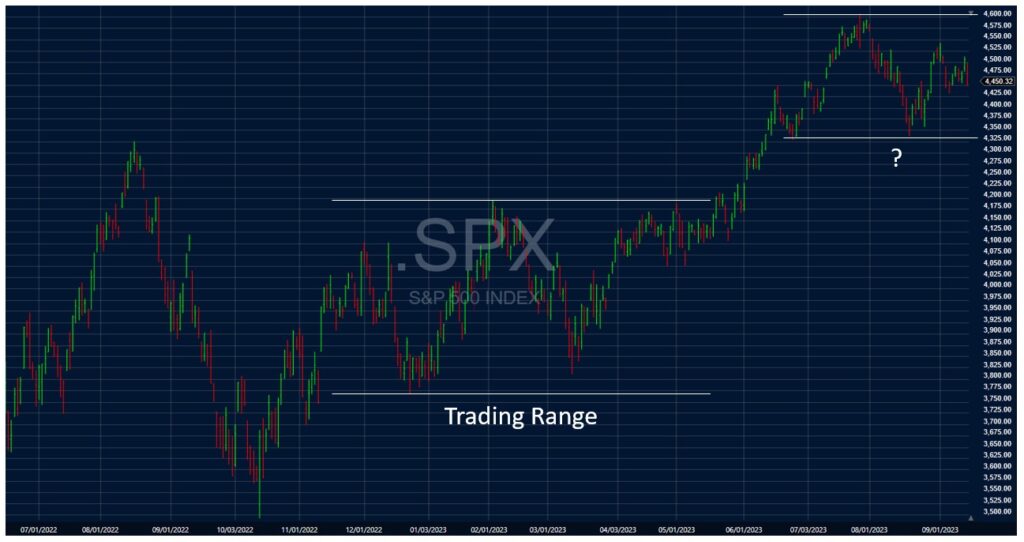I hope you all had a nice Labor Day holiday, and the end of your summer is going well.
You have probably heard something like this exchange before:
Question: What do you think the market is going to do over the next few months?
Answer: It’s going to go up and down.
Sure, that kind of response tends to make people chuckle, but there is also a lot of truth in that answer.
There are certainly periods of time where the market may feel like it’s going straight up (mid-April 2020 through the end of 2021); and there are certainly periods of time when the market feels like it’s going straight down (early January 2022 through October 2022). There are also times when the market trades within a range and such range-bound trading can last for months. These trading ranges can occur during times of transition or uncertainty about the future.
Take a look at this chart of the S&P 500. The chart begins in late June 2022 and runs through mid-September 2023.

If you remember, the market started down in early January 2022 and finally hit bottom in mid-October (the lowest point on this chart). Then from mid-November 2022 until June of this year the market traded in a range between S&P 3,800 and 4,200. During that time, there were many questions about whether the Federal Reserve would continue to raise short-term rates, whether inflation was coming down fast enough, and whether the US economy would experience a recession. Many pundits were predicting a mild recession in the second half of 2023.
In June of this year, there was a shift in the thinking of many market participants. The US economy seemed to be powering through, the Federal Reserve seemed to be closer to the end of their hikes than the beginning, and corporate earnings for the second quarter of 2023 came in better than expected, with some reporting better-than-expected forward guidance. The market responded and broke above the S&P 4,200 range and peaked around S&P 4,600 toward the end of July 2023.
Since that time, the market traded down, then up, and now down a bit over the past couple of weeks. Are we in a new trading range? It’s too soon to tell, but it would not surprise me if we did. There are still a lot of questions out there:
- How will the auto workers strike play out and will it impact the broader economy?
- Is the employment market softening in a good way or a bad way?
- Gas prices are heading up, will other prices climb as well – is inflation tamed?
- Is the recent rebound in housing prices a sign that the housing slump is easing?
- Has the Federal Reserve finished hiking rates?
- What will 3rd quarter corporate earnings look like?
While we all like to see markets march ever higher, trading ranges offer investors opportunities as well. For example, for investors that want to put new money to work, trading ranges tend to give you a natural low point to buy into the market. And for investors that want to raise cash and can be patient, a trading range provides a natural high point to sell assets.
There are other strategies we can use when markets are range bound, such as selling covered calls against existing stock positions or using ETFs that mimic that strategy. It’s all about trying to make the most out of whatever market environment in which we find ourselves.
We’ll get another round of corporate earning reports beginning in mid-October and maybe some of these lingering questions will get answered. How they are answered and what we hear during corporate earnings season, will likely determine whether the market trades in a new range or breaks out toward new, all-time highs.
If you have questions or would like to talk, please get in touch.
Cheers!






